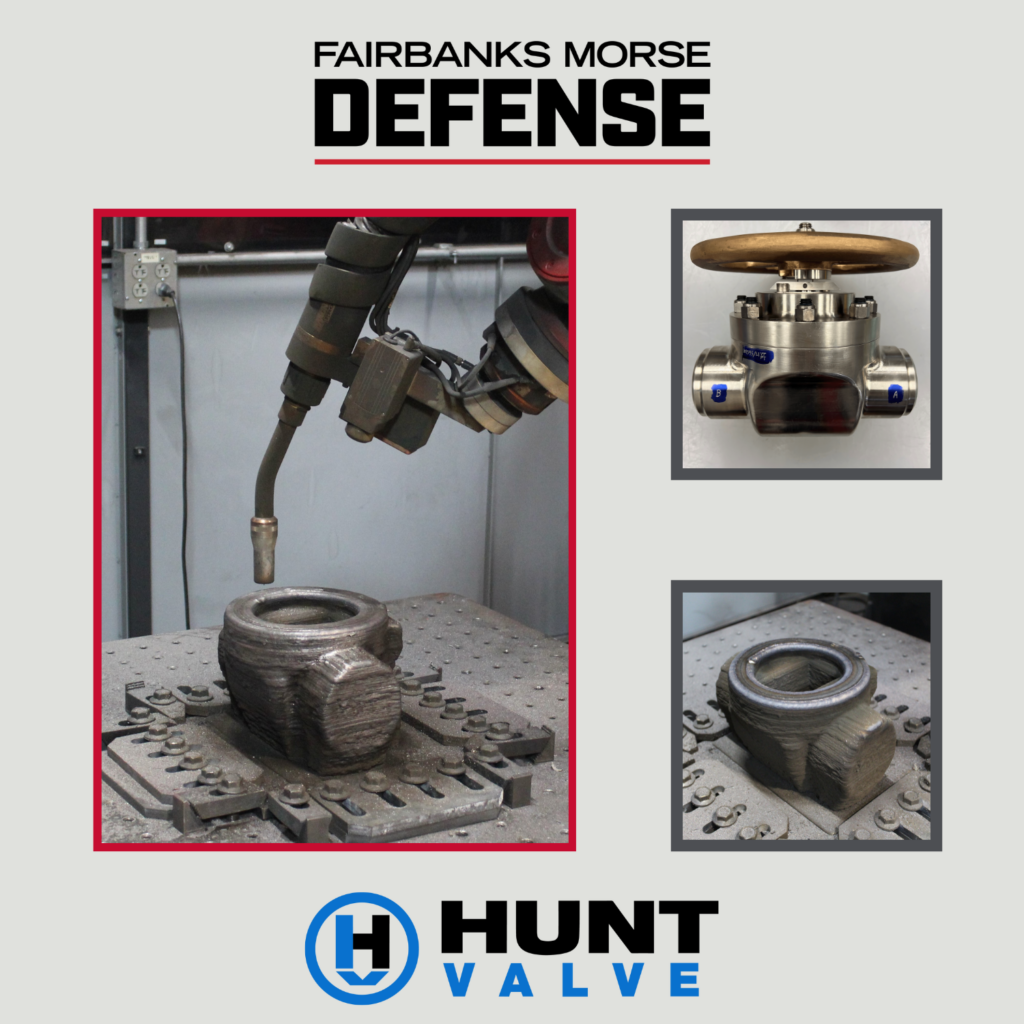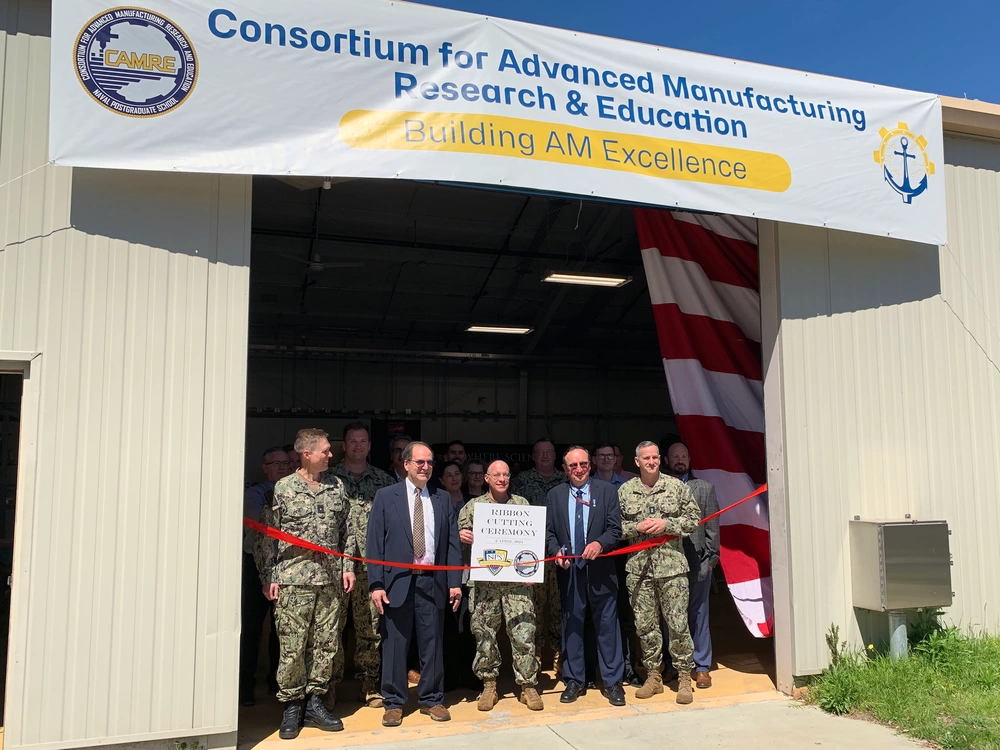Naval Postgraduate School Opens Advanced Manufacturing Center as First Submarine Valve Assembly is 3D Printed
The US Navy’s additive manufacturing (AM) activity saw a striking acceleration in 2023, but as I wrote in November of last year, the branch was just getting warmed up. Bearing that out, this has been an especially busy week for the Navy, with announcements of new capabilities in the realms of both R&D and production.
First, Wisconsin’s Hunt Valve, a division of longtime naval engine supplier Fairbanks Morse Defense (FMD), produced the first 3D printed valve assembly that will be installed on US Navy submarines, a 70-pound component printed in copper-nickel. It’s worth noting here that another organization that has had quite a busy week, Lincoln Electric, is collaborating with Hunt Valve to produce the assemblies. An organization that the Naval Surface Warfare Center, Philadelphia Division (NSWCPD) manages, the Maritime Sustainment Technology and Innovation Consortium (MSTIC), awarded the contract to Hunt Valve.
Additionally, the Naval Postgraduate School’s (NPS) Consortium for Advanced Manufacturing Research and Education (CAMRE) held a ribbon-cutting ceremony for the new NPS Advanced Manufacturing Center, in Monterey, California. The new facility already includes multiple kinds of metal 3D printing processes compatible with a half-dozen different metal materials, as well as a five-axis CNC machine and in-situ monitoring hardware.
In a press release about the opening of the new NPS Advanced Manufacturing Center, NPS Provost Scott Gartner said, “What we’re talking about here is a transformative change to the way we conceptualize the supply chains. What we’re talking about is the ship — and the fleets, who are nearby in a supporting capacity — provides the parts, as needed, to keep those ships operable, to keep our national defense secure. That’s transformative. The way to make that transformation work is to get all of these stakeholders working together in a kind of pressurized box, thinking about it. And that’s what we’re doing here. You’ve got the fleet, you’ve got the industry, you’ve got the academics, you’ve got other universities all working together — exactly the way that it’s supposed to go to develop innovative outcomes.”
Reinforcing that same concept, in a press release about the first 3D printed valve for US Navy submarines, VP of Aftermarket and Product Development at FMD, Andrew Pfister, said, “The utilization of [AM] assembly with copper-nickel for large valve production is a real step forward for our industry. …Innovative technologies such as [AM] are essential for building the submarine industrial base to overcome supply chain challenges. By scaling [AM], we can reduce shipping from other parts of the world and increase the speed of production at home — which positively impacts the Navy’s overall strategic goal to deliver a 300+ fleet.”
Relevantly, FMD recently acquired submarine components manufacturer AMMCON, based in Jacksonville, Florida, which worked with Huntington Ingersoll Industries and General Dynamic Electric Boat to 3D print the first deck drain assemblies for US Navy submarines.
The key takeaway here is that the US Navy is “learning as it goes”, and it’s doing so at an accelerated rate. Additionally, and relatedly, a feedback loop between R&D and production is solidifying. On top of that, and perhaps most importantly, private industry has internalized these developments as demand signals and is responding in kind.
It is increasingly clear that, unlike in the 2010s, when the US military’s approach to AM largely seemed to involve throwing everything against the wall and seeing what stuck, in the 2020s, a buildup exemplified by strategic continuity is very much underway. Of course, the present era’s acceleration couldn’t happen without the preceding era of “pure research”: that is, the progress occurring now is due to the Department of Defense having determined exactly what “stuck” in the prior decade’s efforts.
Subscribe to Our Email Newsletter
Stay up-to-date on all the latest news from the 3D printing industry and receive information and offers from third party vendors.
You May Also Like
3D Printing News Briefs, April 27, 2024: Research, Digital Dentistry, Cycling, & More
We’re starting today’s 3D Printing News Briefs with some research into 3D printed luminescent quantum-dot polymer architectures and free-form laser beam shaping, and then on to an open source 4-axis...
HP & INDO-MIM Collaborate to Boost Metal 3D Printing in India
HP Inc. and INDO-MIM, a US- and India-based supplier of metal injection molding (MIM) powders and contract manufacturer, have announced that the two companies will collaborate to accelerate additive manufacturing...
3D Printing News Briefs, February 17, 2024: Shot Blasting, Service Bureaus, & More
In today’s 3D Printing News Briefs, we’re starting out with post-processing, as SKZ Würzburg is using a shot blast system from AM Solutions for its research. Moving on to business,...
3D Printing News Unpeeled: Not That Kind of Organ 3D Printing
GKN Aerospace will create a 150 jobs in Trollhattan Sweden with an investment of $60 million part of which comes from the Swedish Energy Agency’s Industriklivet initiative. The investment will...
































